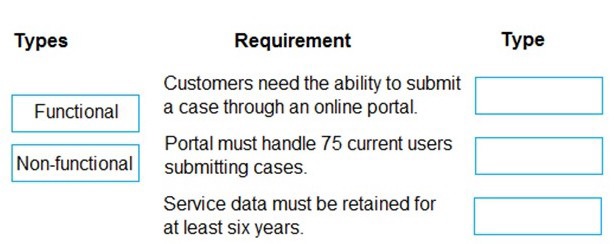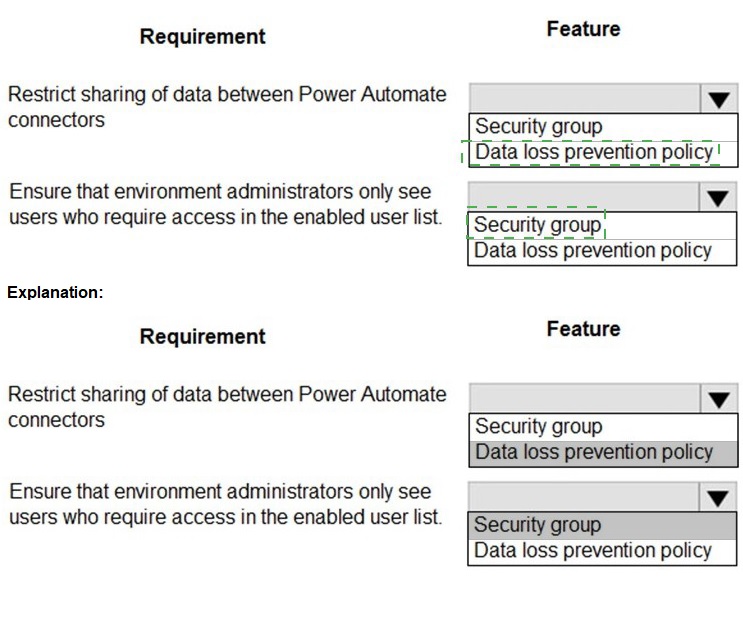Topic 4: Misc. Questions
You are a Power Apps architect for a company. The IT administrator designs a Power Apps
app that is ready to be tested. The company uses application lifecycle management (ALM).
Each version and solution component must be tracked as it is tested.
You need to recommend a strategy to deploy solutions for the user acceptance testing
environment.
What should you recommend?
A.
Use Package Deployer and deploy a managed solution
B.
Use Package Deployer and deploy an unmanaged solution
C.
Use Solution Packager and deploy a managed solution
D.
Use Solution Packager and deploy an unmanaged solution.
Use Solution Packager and deploy an unmanaged solution.
Solution Packager is a tool that can unpack a compressed solution file into multiple XML
files and other files, so they can be easily managed by a source control system.
Unmanaged solution: An open solution with no restrictions on what can be added,
removed, or modified. This is recommended during development of a solution.
C: Managed solution
A completed solution ready to be imported into an organization. Once imported,
components can’t be added or removed, although they can optionally allow further
customization. This is recommended when development of the solution is complete.
Reference:
https://docs.microsoft.com/en-us/power-platform/alm/solution-packager-tool
You need to recommend methods for assigning security to each group of users.
The customer provides the following requirements:
Customers need the ability to submit a case through an online portal.
Portal must handle 75 concurrent users submitting cases.
You need to determine which requirements are functional or non-functional.
Which requirements are functional or non-functional? To answer, drag the appropriate
types to the correct requirements. Each type may be used once, more than once, or not at
all. You may need to drag the split bar between panes or scroll to view content.
NOTE: Each correct selection is worth one point.


Box 1: Functional
Functional requirements describe what the solution needs to do or its behaviors.
Box 2: Non-functional
Non-functional requirements commonly describe non-behavior aspects of the solution such
as performance requirements.
Box 3: Non-functional
Examples of common non-functional requirement types include:
Availability
Compliance/regulatory
Data retention/residency
Performance (response time, and so on)
Privacy
Recovery time
Security
Scalability
A company is struggling to gather insights from won and lost opportunities.
Users must be able to access the company’s solution from mobile and desktop devices.
The solution must meet the following requirements:
Track opportunities and reasons for the win or loss of opportunities in the context
of other related data.
Display data to users as charts and tables and provide drill-through capabilities.
You need to recommend a Power Platform tool to help the client visualize the data.
Which two technologies should you recommend? Each correct answer presents a complete
solution.
NOTE: Each correct selection is worth one point.
A.
Power Bl
B.
Power Automate
C.
Power Virtual Agents
D.
Power Apps
Power Bl
Power Apps
A: Power BI is a business analytics service by Microsoft. It aims to provide interactive
visualizations and business intelligence capabilities with an interface simple enough for end
users to create their own reports and dashboards. It is part of the Microsoft Power Platform.
D: Power BI Apps are an easy way for designers to share different types of content at one
time. App designers create the dashboards and reports and bundle them together into an
app. The designers then share or publish the app to a location where you, the business
user, can access it. Because related dashboards and reports are bundled together, it's
easier for you to find and install in both the Power BI service (https://powerbi.com) and on
your mobile device. After you install an app, you don't have to remember the names of a lot
of different dashboards or reports because they're all together in one app, in your browser
or on your mobile device.
Reference:
https://docs.microsoft.com/en-us/power-bi/consumer/end-user-apps
You are designing the security model for a Power Platform solution.
The security model must meet the following requirements:
Restrict sharing of data between Power Automate connectors.
Ensure that environment administrators only see users who require access in the
enabled user list.
You need to recommend security features for the solution.
What should you recommend? To answer, select the appropriate options in the answer
area.
NOTE: Each correct selection is worth one point.


Box 1: Data loss prevention policy
Data loss prevention (DLP) policies enforce rules for which connectors can be used
together by classifying connectors as either Business or Non-Business. If you put a
connector in the Business group, it can only be used with other connectors from that group
in any given app or flow. Sometimes you might want to block the usage of certain
connectors altogether by classifying them as Blocked.
Box 2: Security group
If your company has multiple Microsoft Dataverse environments, you can use security
groups to control which licensed users can be a member of a particular environment.
A large company experiences high staff turnover rates. As a result, the company must add
or remove multiple system user accounts daily.
You need to recommend a security concept which will facilitate complex security profiles to
entities for large groups of users across the Power Apps and Dynamics 365 applications.
What should you recommend?
A.
Hierarchy security
B.
Field-level security
C.
User access management
D.
Team privileges
Team privileges
User and team management is the area of Microsoft Dataverse where you can create and
maintain user accounts and profiles.
A user is any person who works for a business unit who uses Dataverse. Each user has a
user account.
A team is a group of users. Teams let users across an organization collaborate and share
information.
Note: Why use Dataverse?
Easy to secure – Data is securely stored so that users can see it only if you grant them
access. Role-based security allows you to control access to tables for different users within
your organization.
Data from your Dynamics 365 applications is also stored within Dataverse, allowing you to
quickly build apps
that use your Dynamics 365 data and extend your apps with Power Apps.
Reference:
https://docs.microsoft.com/en-us/powerapps/developer/data-platform/user-team-entities
https://docs.microsoft.com/en-us/powerapps/maker/data-platform/data-platform-intro
A company is implementing Dynamics 365 Sales.
The company has turned off out-of-the-box quote calculations in order to implement its own
custom calculations.
When users update a line item on a quote, they expect to see an updated total for the
quote in real time. Users are reporting inconsistent behavior, with some aggregations
taking up to two hours.
You review the system design and notice many asynchronous workflows.
You need to recommend a solution to enable the calculation in real time.
Which two options should you recommend? Each answer presents a complete solution.
NOTE: Each correct selection is worth one point.
A.
Consolidate asynchronous workflow into a single real-time workflow.
B.
Consolidate multiple asynchronous workflows into a single asynchronous workflow.
C.
Implement a business process flow to replace the existing workflows.
D.
Convert the asynchronous workflows to a synchronous plug-in.
Consolidate asynchronous workflow into a single real-time workflow.
Consolidate multiple asynchronous workflows into a single asynchronous workflow.
You are designing a self-service portal for a company.
The portal must meet the following requirements:
Customers must be able to submit and review cases.
Customers must be able to chat with service representatives in near real time.
Allow service representatives to select cases from queues and use knowledge
articles to resolve customer concerns.
You need to recommend solutions for the company that do not require custom
development.
Which three apps or services should you recommend? Each correct answer presents part
of the solution.
NOTE: Each correct selection is worth one point.
A.
Dynamics 365 Field Service
B.
Dynamics 365 Customer Service
C.
Omnichannel for Customer Service
D.
Customer Insights
E.
Customer self-service portal
Dynamics 365 Customer Service
Omnichannel for Customer Service
Customer self-service portal
A company plans to create a Power Platform solution that integrates with Dynamics 365
Sales.
The solution must meet the following requirements:
Connect directly with a Microsoft Azure SQL database as an external data source
at run time where specific data is available in the Dynamics 365 Sales solution
without the need for data replication.
An external system needs to send data to the company’s Dynamics 365 Sales
solution.
You need to recommend the most suitable solution to integrate Dynamics 365 Sales with
both systems.
What should you recommend? To answer, select the appropriate option in the answer
area.
NOTE: Each correct selection is worth one point.


Graphical user interface, text, application
Description automatically generated
Box 1: Use Virtual tables
A virtual entity is a custom entity in Dynamics 365 Customer Engagement (on-premises)
that has fields containing data from an external data source. Virtual entities appear in your
app to users as regular entity records, but contain data that is sourced from an external
database, such as an Azure SQL Database. Records based on virtual entities are available
in all clients including custom clients developed using the Dynamics 365 Customer
Engagement Web Services.
Box 2: Use Dynamics 365 Web API.
Dynamics 365 Web Services API: Many times, straight database-to-database integrations
aren’t a possibility. In these cases, the development of a solution may depend on utilization
of the Dynamics 365 Customer Engagement web services API (Application Programming
Interface).
You are conducting performance testing for a Microsoft Power Platform solution. The
solution uses Power Automate cloud flows to query and synchronize data across 10
different tables based on various criteria. You make the following observations:
• Internet speed during testing is fast (500 Mbps).
• There are 50 Dynamics real-time workflows in use.
• There are 63 Dynamics asynchronous workflows in use.
• There are 76 Power Automate cloud flows in use.
You identify the following performance issues;
You need to recommend steps to resolve the performance issues.
What should you recommend? To answer, select the appropriate options m the answer area.
NOTE: Each correct selection is worth one point.


Box 1: Reduce usage of near real-time workflows
A real-time workflow can be converted to asynchronous workflow and back to real-time.
Box 2: Convert all Dynamics 365 workflows to Power Automate cloud flows.
Workflows are limited to Microsoft Dynamics 365/CRM application only.
Power Automate can span across multiple web-based services or applications at the same
time.
Dynamics 365 CRM Workflows can be converted to Power Automate flows
A company has a custom web-based solution that is hosted on Azure. You design a Power
Platform solution to provide the company additional capabilities.
You need to integrate the Power Platform solution with the web-based solution.
What should you recommend?
A.
Connection reference
B.
Custom connector
C.
Desktop flow
D.
Data gateway
Custom connector
A custom connector in Power Platform is a wrapper around a REST API that allows Power
Automate or Power Apps to communicate with that REST API. Connectors created in
Power Automate are available in Power Apps. Likewise, connectors created in Power Apps
are available in Power Automate.
Reference:
https://docs.microsoft.com/en-us/learn/modules/create-custom-connector-powerplatform/
1-introduction
| Page 5 out of 20 Pages |
| Previous |